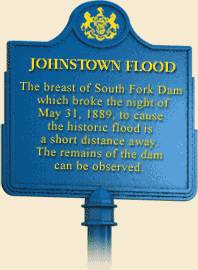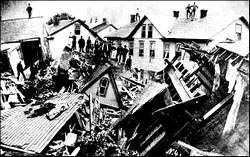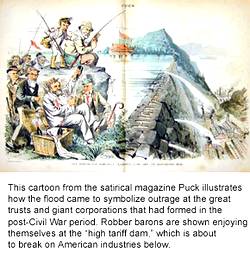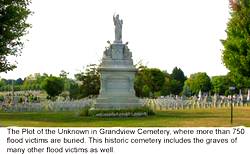|
The Johnstown Flood Museum
|
 Next to the assignation of Abraham Lincoln, the Johnstown Flood was the most publicized story in the late 1800s. The infamous flood is well known as one of the most historically tragic events in U.S. History.
Next to the assignation of Abraham Lincoln, the Johnstown Flood was the most publicized story in the late 1800s. The infamous flood is well known as one of the most historically tragic events in U.S. History.
Reporters came from all over the country to take pictures and get the tragic stores first hand. The story had all the elements journalist dream of, a resort owned by the wealthy, the perfect storm, and a neglected dam bursting to drown a poor community of mostly immigrants.
More than 2200 people were known to be dead and thousands more people injured in the tragic famous flood. Homes, businesses, railroad tracks, derailed trains were stacked up in every direction. With the telegraph lines down and the railroad tracks destroyed the country had no way of getting any information of the devastating disaster. Reporters traveled from all over the U.S. to get the story.
 On May 31, 1889, at about 3:10 PM the South Fork Dam gave way. After two days of heavy downpours the old South Fork Dam started showing stress. The President of the prestigious hunting and fishing club, Elias Unger, sent a telegraph to the city of Johnstown, PA to warn them of a possible flood. He called out Irish immigrants to work on the dam for hours in the downpour before the dam spilled over and finally burst.
On May 31, 1889, at about 3:10 PM the South Fork Dam gave way. After two days of heavy downpours the old South Fork Dam started showing stress. The President of the prestigious hunting and fishing club, Elias Unger, sent a telegraph to the city of Johnstown, PA to warn them of a possible flood. He called out Irish immigrants to work on the dam for hours in the downpour before the dam spilled over and finally burst.
A woman by the name of Hettie Olge worked in the telegraph office and took her last telegraph that day at about 3:00 PM. The telegram was the warning of the dam breaking. They never found Hettie's body. Her keys are on display at the Johnstown Flood Museum.
SEE WHAT OTHER VISITORS HAVE SHARED
Just click on the link below - it's so easy!
Share Your Pictures of Pennsylvania and Memories
Two Fascinating Johnstown Flood Museums
Both Johnstown Flood Museums have unique history and attractions. By visiting both memorials you will actually realize the full story of that dreadful day. One is located in the heart of Johnstown, PA and the other is located at the South Fork Dam. The story is not only of a great tragedy it's also a story of a great triumph.
When you pay to visit both Johnstown Flood Museums you also are paying for the admission to an extremely interesting museum also located in Johnstown. It's called The Heritage Discovery Museum .
There were 16 cottages and a clubhouse on the banks of Lake Conemaugh. The industrialists of Pittsburgh owned and maintained the 160 acres and reservoir. It was a quick get away from the dirt and heat of the big city.
When the dam broke many of the survivors of the Johnstown Flood were angry and went to the small resort and broke windows and did some property damage. Since it was still the off season for the resort not many of the club member were there. The few that were there left immediately. They went back to their lives in Pittsburgh, and didn't say too much about the incident. It didn't take long for a cartoon of the incident to appear in magazine.
 The cartoon was to symbolize the industrialists taking advantage of the riches at the dam and the outrage of the industrial community that was left to deal with the aftermath.
The cartoon was to symbolize the industrialists taking advantage of the riches at the dam and the outrage of the industrial community that was left to deal with the aftermath.
The club members started donating blankets and money to the relief effort. The entire experience and outrage had a rippling effect that lead into Pittsburgh and caused a steel strike. The news media had a field day with the story of the Johnstown Flood and it spread all over the country.
The Entire Country Pulled Together
Relief effort came from across the country. The first relief train arrived from Pittsburgh on June 1. Buffalo Bill Cody gave a benefit show in Paris. Trains started arriving at a steady pace, filled with supplies to rebuild, food, and medical teams. Within 14 days after the Johnstown Flood disaster, the Pennsylvania Railroad rebuilt the tracks and supplies were able to arrive on a daily bases.
Prefabricated houses started arriving and rebuilding began. These houses were and still are known as the Oklahoma houses. You will see one of these houses when you visit the South Fork Dam's Johnstown Flood Museum.
 The Grandview Cemetery is known as the Johnstown PA Famous Flood Cemetery. More than 750 flood victims are buried here. Many of the graves are marked unknown. Victims were discovered as far away as Pittsburgh, many months after the Johnstown Flood.
The Grandview Cemetery is known as the Johnstown PA Famous Flood Cemetery. More than 750 flood victims are buried here. Many of the graves are marked unknown. Victims were discovered as far away as Pittsburgh, many months after the Johnstown Flood.
Johnstown is also known as the Flood City. There was another tragic flood in 1936 and again in 1977. Read how the world famous Johnstown Incline Plane saved lives in the 1936 flood and again in the 1977 flood. The 1936 flood thankfully had fewer casualties, only 24, but the water crested higher than the previous flood.
I personally remember the flood in 1977. I lived in Altoona, PA and volunteers from all over the Allegheny Mountains were arriving to help in any way possible. I worked in a donut shop at the time and we worked many hours overtime making donuts and hot coffee to send to the relief workers.
Even though this flood wasn't as devastating as the first famous flood it was still heartbreaking. Johnstown, PA is a city to be admired. The community has faced generations of disasters and still keep their heads held high and keep on surviving.
While you are in the area visit other Pennsylvania National Memorials . Like one of our most recent additions, Flight 93 Memorial . It really isn't very far from the Johnstown area.
Return from Johnstown Flood Museum to Pennsylvania Memorials
Return To Pennsylvania Mountains of Attractions Home





